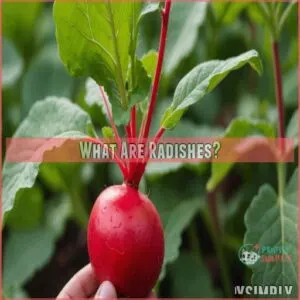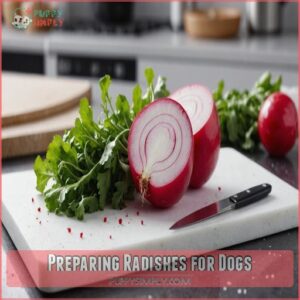This site is supported by our readers. We may earn a commission, at no cost to you, if you purchase through links.
 Yes, your dog can eat radish, but it’s wise to serve it in moderation.
Yes, your dog can eat radish, but it’s wise to serve it in moderation.
Radishes aren’t toxic to dogs and pack fiber, potassium, and vitamin C, though alongside a bit of gas.
While Toby might prefer carrots or sweet potatoes, a crunchy radish can still be a fun treat.
Keep in mind, though, too many can turn your pup’s tummy into a rumbling thunderstorm.
Always chop them up to avoid choking hazards.
Curious about which radish types are best for your furry friend? If you’re considering adding radishes to your dog’s diet, learning about other vegetables like safe spinach feeding tips can also help you make informed decisions. Stay tuned for more insights and tips on serving radishes to dogs safely and deliciously.
Table Of Contents
- Key Takeaways
- What Are Radishes?
- Are Radishes Safe for Dogs
- Types of Radishes for Dogs
- Preparing Radishes for Dogs
- Serving Sizes for Dogs
- Can Dogs Eat Radish Varieties
- Radish Allergy and Intolerance
- Including Radishes in Dog Food
- Consulting a Veterinarian
- Frequently Asked Questions (FAQs)
- Can dogs eat roasted radishes?
- Are radish leaves safe to eat?
- Can dogs eat radish greens?
- How much radish should a dog eat?
- What happens if my dog eats a radish?
- How much radish can I give my dog?
- Can dogs eat radishes and celery?
- What vegetables are not good for dogs?
- Do radishes affect a dogs dental health?
- Can radishes help with dog weight management?
- Do radishes cause gas in dogs?
- Are there benefits of radish for dog skin?
- How do radishes impact dog hydration?
- Conclusion
Key Takeaways
- You can feed your dog radishes in moderation; they’re safe and nutritious but may cause tummy troubles if overfed.
- Always chop radishes into small, manageable pieces to avoid choking hazards.
- Avoid giving your dog radish greens, as they can lead to stomach upset and diarrhea.
- Consult your vet before adding new foods like radishes to your dog’s diet, especially if your pet has food sensitivities.
What Are Radishes?
At first glance, you might think of radishes as merely the colorful crunch in your salad.
However, these root vegetables boast a fascinating history and are packed with nutrients.
Radishes, which come in various varieties like red, white, and even black, have been cultivated for centuries.
Some pet owners also consider radishes as a nutritious addition to their dog’s diet, which might align with the concept of a more natural and biologically appropriate diet, similar to grain-free dog food.
They thrive in temperate climates, making them a staple in many home gardens.
Beyond their peppery bite, radishes provide a good source of vitamin C, potassium, and fiber.
Any surplus can be easily stored in the fridge, ensuring you have a fresh supply all year round.
While their bold taste mightn’t be every dog’s favorite, knowing about radish safety for dogs is a nifty tidbit for pet owners.
Are Radishes Safe for Dogs
You might be wondering if your furry friend can munch on radishes, and the good news is, they can!
Radishes are generally safe for dogs when given in moderation, though some pups may not enjoy their sharp taste.
Radish Leaves and Toxicity
You’ve probably wondered, can dogs eat radish greens.
It’s a worry many dog owners share.
Radish leaves might look innocent, but they’re not the best treat for your furry friend.
They can lead to stomach upset, vomiting, and diarrhea.
Even if your pooch loves veggies, it’s better to stick to dog-safe choices for their well-being.
However, if you’re looking to introduce root vegetables into your dog’s diet, safe root vegetables for dogs like carrots, sweet potatoes, and beets can be a great option.
Benefits of Radishes for Dogs
Radishes can pack a surprise punch for your dog’s diet, offering nutrition and health perks.
They enhance digestive health with their fiber content and provide a vitamin boost.
Their antioxidant power helps fight off free radicals, while hydration support comes from high water content.
Radishes are perfect for weight management, helping keep your furry friend in shape.
- Digestive health boost
- Vitamin enrichment
- Antioxidant defense
- Hydration and weight control
Precautions and Considerations
A tiny bit of radish can be a fun treat for your pup, but remember moderation is key.
Always start with a small amount to check for any tummy troubles like loose stool or diarrhea.
Consider your dog’s size and dietary needs; a Great Dane needs more than a Chihuahua!
Freshness matters; use only crisp radishes.
Remember, radishes are a supplement, not a complete and balanced diet, so keep them as occasional dog treats.
Observe your dog’s individual tolerance.
Improved Digestion
Imagine your dog prancing happily, thanks to improved digestion from radishes. These crunchables boost digestive health by increasing fiber intake.
Here’s how they help:
- Constipation relief: Fiber helps keep things moving.
- Diarrhea prevention: Balances gut bacteria.
- High fiber foods: Supports overall health.
- Radish nutrition: Adds essential nutrients.
Ensure moderation, and you’re all set!
Rich in Vitamins and Minerals
Aiding dog’s digestion is fantastic, but did you know radishes are also rich in vitamins and minerals?
Packed with vitamin C and potassium, these colorful crunchies add to your dog’s nutritional lineup.
They’re low calorie snacks too, perfect for managing dog obesity while enhancing overall dog nutrition.
Keep it safe; remember, moderation is key when sharing radishes.
Antioxidant Properties
Why consider radishes for your dog?
Well, they pack antioxidant properties that combat free radical damage and bolster the immune system.
Including radishes in dog food can enhance dog health, offering antioxidant benefits.
When used in moderation as part of vegetables for dogs, radishes contribute positively to your dog’s nutrition.
Always opt for small portions to make sure safety.
Hydration and Weight Management
Offering radishes to your dog can boost hydration and support weight management.
With their high water content, radishes help keep your pup hydrated.
Their low calorie count makes them a healthy snack for diet plans.
Consider these benefits:
- Water intake increases
- Lowers dog weight concerns
- Fits into good canine diet
- Aligns with dog feeding guidelines
Types of Radishes for Dogs
When it comes to feeding radishes to your furry friend, knowing the types is essential for safety.
Not all radishes are the same, so let’s explore which ones are suitable for your dog and which should be avoided.
White Radishes
For white radishes, you’re in luck—they’re gentler on a dog’s palate than their red counterparts.
These milder root vegetables pack a punch with nutrients like vitamin C and potassium.
For preparation, peel and slice them into bite-sized pieces.
Always offer a small serving size to start, ensuring your pup enjoys this crunchy treat safely.
Dark Radishes
Dark radishes, unlike their milder white cousins, boast a stronger, peppery flavor.
Their dark color comes from anthocyanins, antioxidants also found in blueberries!
While safe in small amounts, remember moderation is key.
Too much dark radish might upset your pup’s tummy.
Always introduce new foods gradually, and watch for any unusual reactions.
If you’re unsure, chat with your vet.
They’re always happy to help!
Radish Greens and Toxicity
Let’s navigate from dark radishes to the world of radish greens.
These leafy tops may seem harmless, but they can cause digestive upset for your furry friend.
For dog safety, avoid radish greens and opt for alternative greens in your puppy’s diet.
- Keep toxicity levels in check.
- Consult veterinary care for radish serving sizes.
- Consider fruits for dogs instead.
Horseradish and Wild Radishes
Steering clear of horseradish, known for its toxicity in dogs, is a must.
Unlike your typical radish, horseradish poses real health risks.
Similarly, wild radishes aren’t as friendly as their garden-grown cousins and bring dangers lurking.
Instead, explore safe radish alternatives and AAFCO-approved foods.
Stick to raw radishes as occasional treats, ensuring your dog’s diet stays both tasty and healthy!
Preparing Radishes for Dogs
When preparing radishes for your dog, start by washing and trimming them to remove any dirt or leaves.
Serve the radishes raw or cooked, diced into small pieces to avoid choking hazards while ensuring your pet’s safety.
Washing and Trimming
Imagine you’re prepping radishes for your dog.
First, rinse them under cold water to remove dirt — don’t forget the crevices!
Trim leaves and smaller roots for safety.
Some pups like roasted radishes; others love them raw.
Remember these safety tips:
- Trimming leaves
- Check radish size
- Use proper washing technique
- Remove all dirt
- Follow safety precautions
Dicing and Grating
After you’ve washed and trimmed the radishes, focus on dicing and grating them properly for your furry friend.
Using a trusty grating tool or a sharp knife, create bite-sized pieces perfect for your dog’s safe snacking.
You can also find helpful dog eat radish products online dog eat radish supplies.
Pay attention to the radish size and shape, ensuring they’re easy to chew, while practicing chopping safety to avoid mishaps.
Serving Raw or Cooked
Ever wondered about serving radishes raw or cooked to your pup?
Raw radishes offer a crunchy texture that some dogs might love, while cooking can soften them for easier digestion.
Consider your dog’s texture preference and any digestive impact.
Whether you choose raw or cooked, balance these choices with your pet’s overall diet and safety concerns.
Avoiding Choking Hazards
To prevent choking, always chop radishes into tiny pieces, matching the radish size to your dog’s breed.
Smaller dogs need smaller pieces!
Think of it like this: a Great Dane can handle bigger chunks than a Chihuahua.
These Chopping tips make sure safe serving.
Consider using a grater for extra-small pieces.
Remember, even seemingly harmless treats can pose a risk if not prepared correctly.
Chew toys can help, but careful preparation is key.
Serving Sizes for Dogs
When serving radishes to your dog, it’s important to choose the right portion size based on their breed and size.
By starting small and gradually increasing, you make sure your pet enjoys the benefits without any digestive surprises.
Small Breeds and Radish Portions
Tiny pups can enjoy radishes too, but keep portions small. Start with just a 1/4-inch cube. You can also find dog safe radish products online at radish dog treats.
It may sound tiny, but for your little buddy, that’s a hearty snack!
Ensuring proper Small Breed Nutrition involves balancing those small cubes as part of their diet.
Remember, overdoing Puppy Radish Intake can lead to tummy troubles, so moderation is key.
Medium Breeds and Radish Portions
After sorting out radish portions for smaller breeds, let’s now focus on medium-sized pups.
For dogs weighing between 31-50 pounds, a sensible bite would be a 1-inch cube of diced radish.
Such radish portioning complements breed-specific diets and boosts canine nutrition.
This little treat, packed with fiber, promotes digestive health while keeping your medium breed happy and active.
Large Breeds and Radish Portions
Managing radish portions for your large breed pup might seem tricky, but keep it simple.
- Breed-Specific Radish Diets: Tailor the amount.
- Radish Feeding Frequency: Moderate servings avoid overconsumption.
- Large Breed Nutrient Needs: Complement, don’t replace meals.
- Giant Breed Radish Safety: Watch for adverse reactions.
Two 1-inch cubes are usually a safe start.
Extra-Large Breeds and Radish Portions
Is your giant pooch eyeing that radish?
For extra-large breeds, aim for three 1-inch cubes of diced radish as a safe serving amount.
This guarantees they’re getting a tasty treat without overloading their diet.
Giant breed diets benefit from variety, but be cautious—watch for any radish allergy symptoms.
Balance is key in large dog nutrition!
Can Dogs Eat Radish Varieties
Considering feeding your dog radishes, you might wonder if they can enjoy different varieties like roasted radishes or combinations with other vegetables such as celery.
Understanding which radish varieties are safe and how to incorporate them into your dog’s meals can help guarantee their health while giving them a taste of something new.
Roasted Radishes
Introduced to roasted radishes yet?
Their warm, mellow flavor is a hit. Dogs can try them, but skip the seasoning to keep it safe and simple.
A sprinkle of unseasoned roasted radishes adds a twist to their diet, though it’s best to offer in moderation.
Remember, a plain radish is the goal—no frills, just natural goodness!
Radishes and Celery
While roasted radishes charm some pups, you might wonder about pairing radishes with celery.
Dogs can indeed munch on both, but ease into it—nibbles of these crunchy snacks offer a delightful raw crunch.
Think of radish and celery juice as a healthy chew for curious canines, but always check with your vet before spicing up their diet with celery sticks!
Other Vegetable Combinations
Want to spice up your dog’s diet? Try mixing radishes with veggies like carrot and apple or beet and sweet potato.
They add crunch and color!
How about a Green Bean Delight or a Pumpkin and Peas combo?
Keep it safe with spinach and zucchini.
Dogs love variety, so these mixes might make mealtime a tail-wagging event!
Radish Allergy and Intolerance
When feeding your dog radishes, watch for any signs of allergy or intolerance like itching, swelling, or stomach upset.
If your furry friend shows these symptoms, stop feeding them radishes and consult with your veterinarian to prevent further issues, especially if they experience severe stomach upset.
Signs of Adverse Reactions
So, you’ve tried radishes – great.
If your dog experiences an adverse reaction, it could be a sign of a larger issue, such as environmental allergies, which can be triggered by various factors, including pollen or pet dander.
Keep an eye out for these signs of a radish reaction:
- Vomiting
- Diarrhea
- Skin rash
If you see any of these, it might be time for Food Intolerance Testing or a chat with your vet. Remember, a little radish goes a long way!
What to Do in Case of Emergency
If your dog suffers a radish reaction, swift action is key.
First, use Pet First Aid: stop the radish consumption.
If you have been using radish-based products, such as supplements from Radish Dog Food, identify swelling or vomiting as Radish Poisoning symptoms.
In a Canine Emergency, you might perform Dog CPR if breathing stops.
Regardless, seek Veterinary Help immediately to make sure your furry friend’s safety and health are maintained.
Preventing Allergic Reactions
You’ve mastered emergency actions, now let’s keep allergic reactions at bay.
Radish can trip up a dog with skin issues or food intolerance signs.
Avoid surprises with a little prep:
- Test a tiny portion to watch for radish allergy symptoms.
- Observe their skin for unusual changes.
- Consult your vet for pet sensitivity tests to strengthen the canine immune system.
Including Radishes in Dog Food
You can safely mix radishes into your dog’s meals by chopping them into small, manageable pieces.
This allows you to blend them with other nutritious ingredients.
Keep an eye on your furry friend’s reaction to make sure they’re enjoying this crunchy treat without any adverse effects.
Mixing With Other Foods
While watching for allergy signs, you might consider adding radishes to your dog’s meals to spice things up.
Try mixing radishes with lean meat, sweet fruits like apples, or other veggies for a tasty and nutritious combo.
These fun, healthy mix-ins also provide variety but can also serve as a smart alternative to regular pet food options.
Monitoring Progress
As you start on this radish adventure with your pup, remember portion control is key, just like when giving your dog safe low-calorie treats.
Note down observations in your Pet Food Diaries, checking for any signs during Radish Tolerance Tests.
Keep entries in your Canine Nutrition Logs so you can spot patterns and adjust diets.
It’s like playing detective, but way more fun!
Consulting a Veterinarian
When you’re considering adding radishes to your dog’s diet, be sure to consult with your veterinarian.
They can offer personalized advice and help you monitor for any adverse reactions, ensuring your pet’s health and safety.
Before Feeding Radishes
Mixing radishes into dog food can spruce up mealtime, but pump the brakes before diving into your pup’s diet.
Consulting your vet makes sure you’re barking up the right radish. They’ll help spot any issues, especially if your doggo throws a fuss over food tweaks.
Radish Source Matters: go organic, buy fresh, and store with care for peak pup pleasure.
In Case of Adverse Reactions
Several signs indicate a problem: vomiting, diarrhea, or skin reactions.
If you see any of these, don’t panic, but act fast! Contact your vet immediately.
Early intervention is key for managing Radish Toxicity and preventing further Canine Sensitivities.
Remember, prevention is better than cure, so always introduce new foods slowly.
Your vet can offer personalized advice on managing Food Allergies and Emergency Response strategies.
For Personalized Advice
Notice your dog’s reaction to radishes?
Consulting a vet makes sure you’re on the right track with customized diet plans.
Discuss pet nutrition goals and breed-specific advice to cater to your pup’s unique needs.
Vets can help with identifying dog-safe fruits like honeydew and cantaloupe options and help with food allergy testing and manage canine health conditions.
They’re your go-to for expert insights and keeping your furry friend happy and healthy.
Frequently Asked Questions (FAQs)
Can dogs eat roasted radishes?
Your dog can eat roasted radishes.
They should be plain ones without any spices or oils.
Start small to see their reaction.
While they’re generally safe, always consult your vet before adding new foods to their diet.
Are radish leaves safe to eat?
Ever wonder if radish leaves are safe to eat?
They’re edible for humans, packed with nutrients, but have a spicy kick.
Cook them like any leafy green, and you’ll enjoy a unique, peppery twist in your meals.
Can dogs eat radish greens?
Nope, radish greens aren’t safe for your pup. They can cause tummy troubles like vomiting and diarrhea. Stick to the radish itself, but always in moderation!
How much radish should a dog eat?
Start small with radishes for your dog.
Always introduce new foods gradually, watching for any adverse reactions.
An extra-small dog can have a 1/4-inch cube, while a large dog can handle two 1-inch cubes.
What happens if my dog eats a radish?
Like a spicy surprise in your dog’s diet, eating radish mightn’t be a hit with every pup.
It’s generally safe, but watch for signs like upset stomach or diarrhea, and consult your vet if concerned.
How much radish can I give my dog?
For an extra-small dog, 1/4-inch cube is safe.
While a small dog can have a 1/2-inch cube.
Medium dogs can try a 1-inch cube.
Large dogs can have up to two cubes.
Can dogs eat radishes and celery?
You can feed your dog radishes and celery in moderation as they’re low-calorie, crunchy snacks.
Make sure radishes are peeled and diced; celery should be cut into small bites to avoid choking.
Monitor for any adverse reactions.
What vegetables are not good for dogs?
Certain veggies like onions, garlic, and chives can harm your furry friend.
These vegetables can lead to upset stomachs or worse.
Avocados and wild mushrooms also pose risks.
Always check with your vet before adding new snacks.
Do radishes affect a dogs dental health?
Honestly, radishes aren’t known for dental miracles. They’re crunchy, which might help a bit, but don’t replace proper brushing. Always consult your vet for your dog’s dental needs.
Can radishes help with dog weight management?
Radishes can aid in dog weight management due to their low-calorie and high-fiber content.
They promote satiety, making your pup feel fuller longer.
However, always introduce them slowly and consult your vet for dietary changes.
Do radishes cause gas in dogs?
Dogs might experience gas after eating radishes due to their high fiber content.
Watch for excessive flatulence or tummy troubles.
Start with small amounts, monitor reactions, and always consult your vet before making diet changes.
Are there benefits of radish for dog skin?
While radishes provide vitamins and minerals beneficial for overall health, their direct impact on dog skin is unclear.
However, their antioxidant properties may help reduce inflammation and promote healthy skin in dogs.
How do radishes impact dog hydration?
Your dog’s hydration benefits when adding radishes, thanks to their high water content.
This veggie can help quench thirst, especially for active dogs.
Just introduce them slowly, ensuring they don’t munch too much at once.
Conclusion
So, can a dog eat radish?
Yes, but remember moderation is key.
A tiny bit of this crunchy veggie won’t hurt your furry friend; in fact, it offers some nutritional benefits.
However, too many radishes might cause tummy troubles.
Always chop them finely to prevent choking hazards.
If you’re unsure about introducing radishes into your dog’s diet, it’s always best to chat with your vet.
They can provide advice specific to your dog’s needs and health history, considering factors such as whether certain foods like raw cabbage safety.
Happy snacking!


















